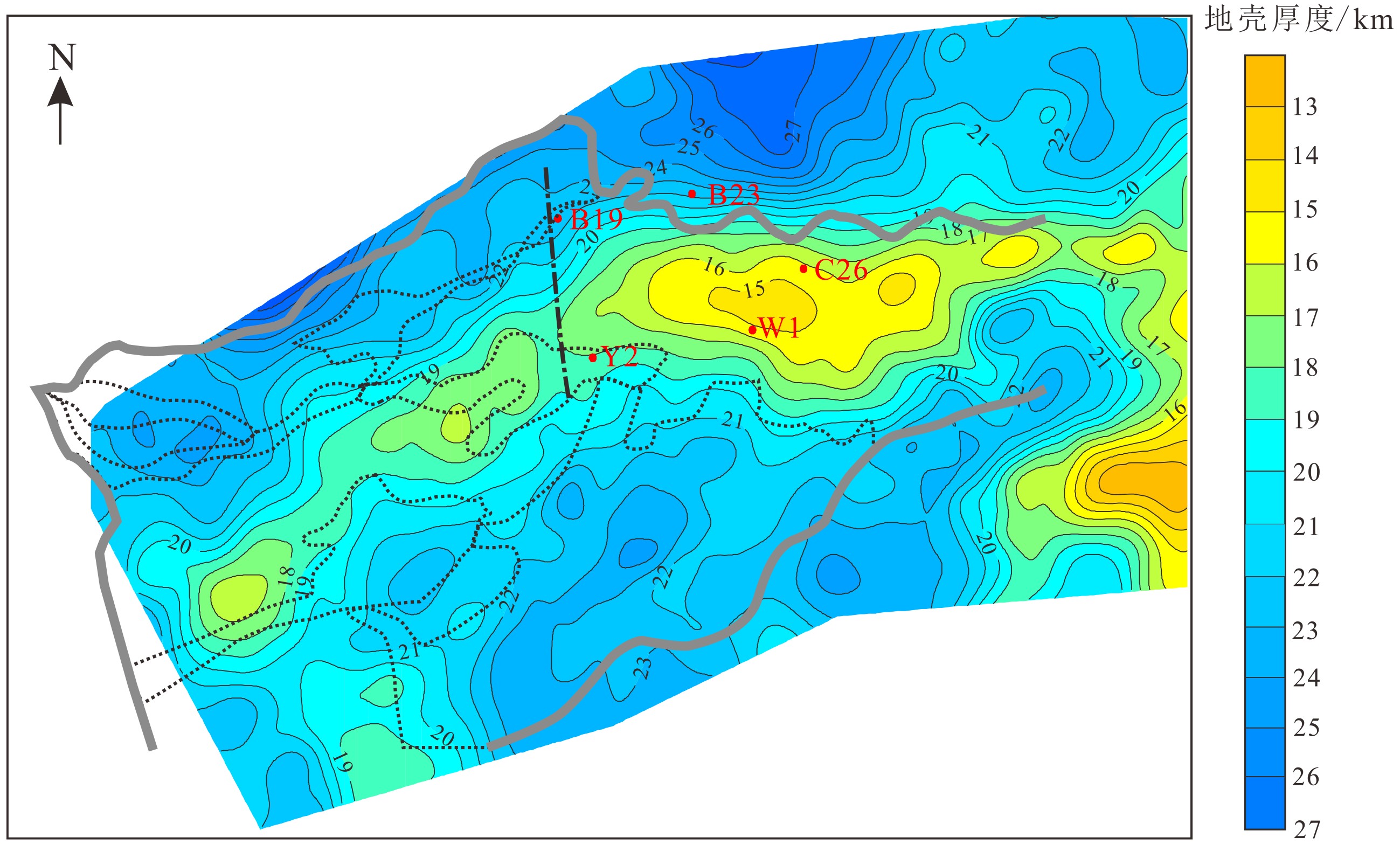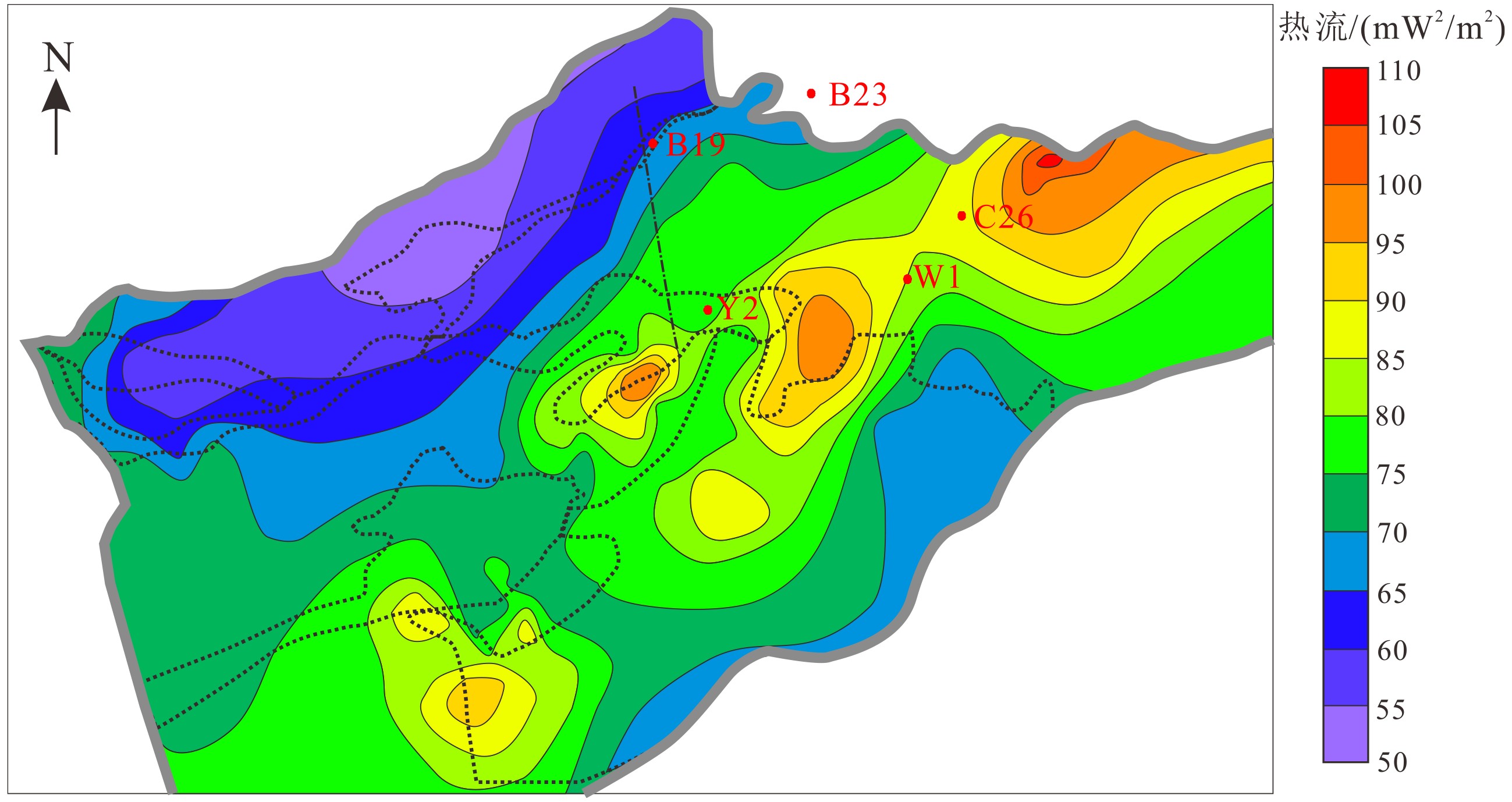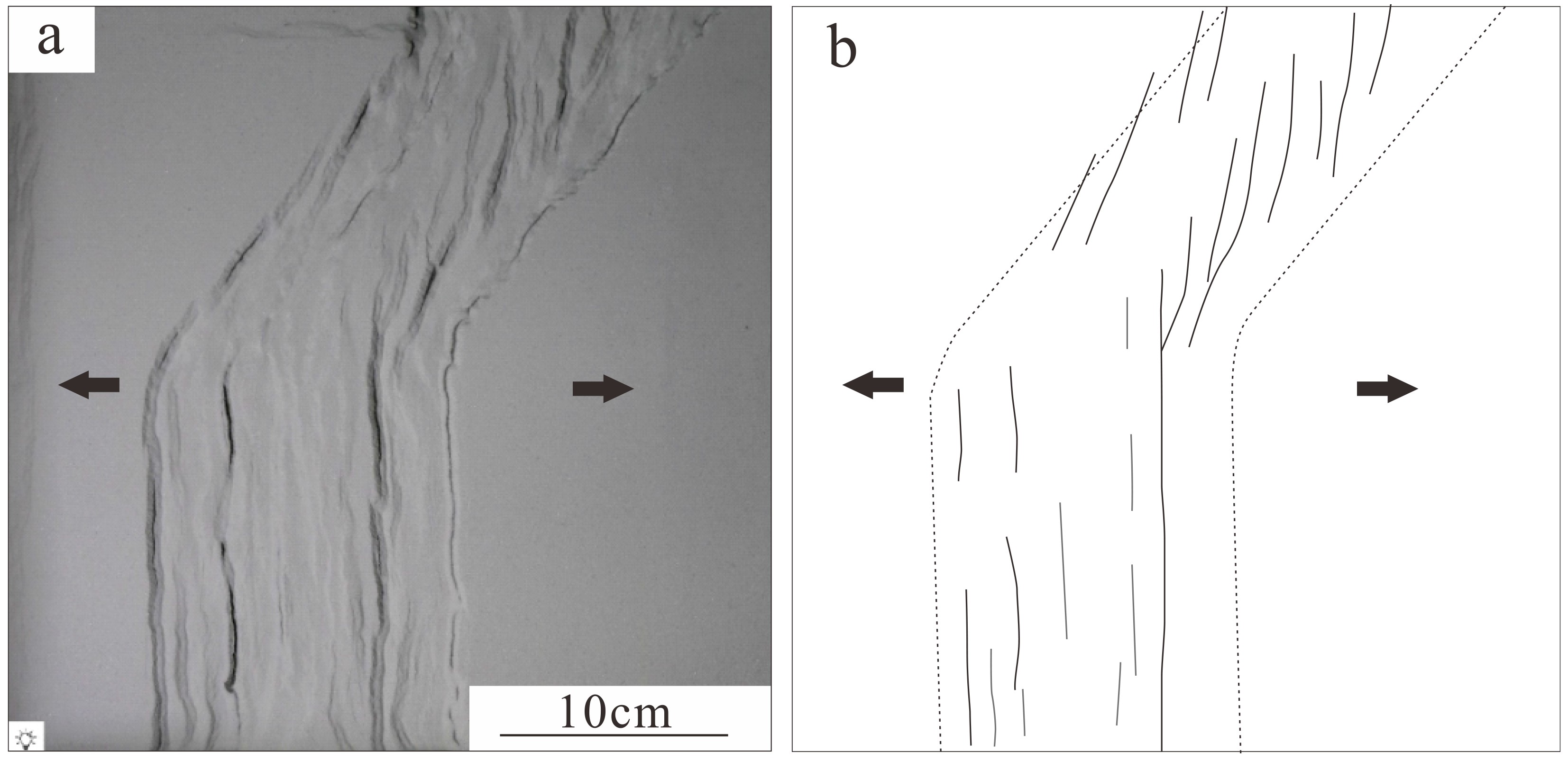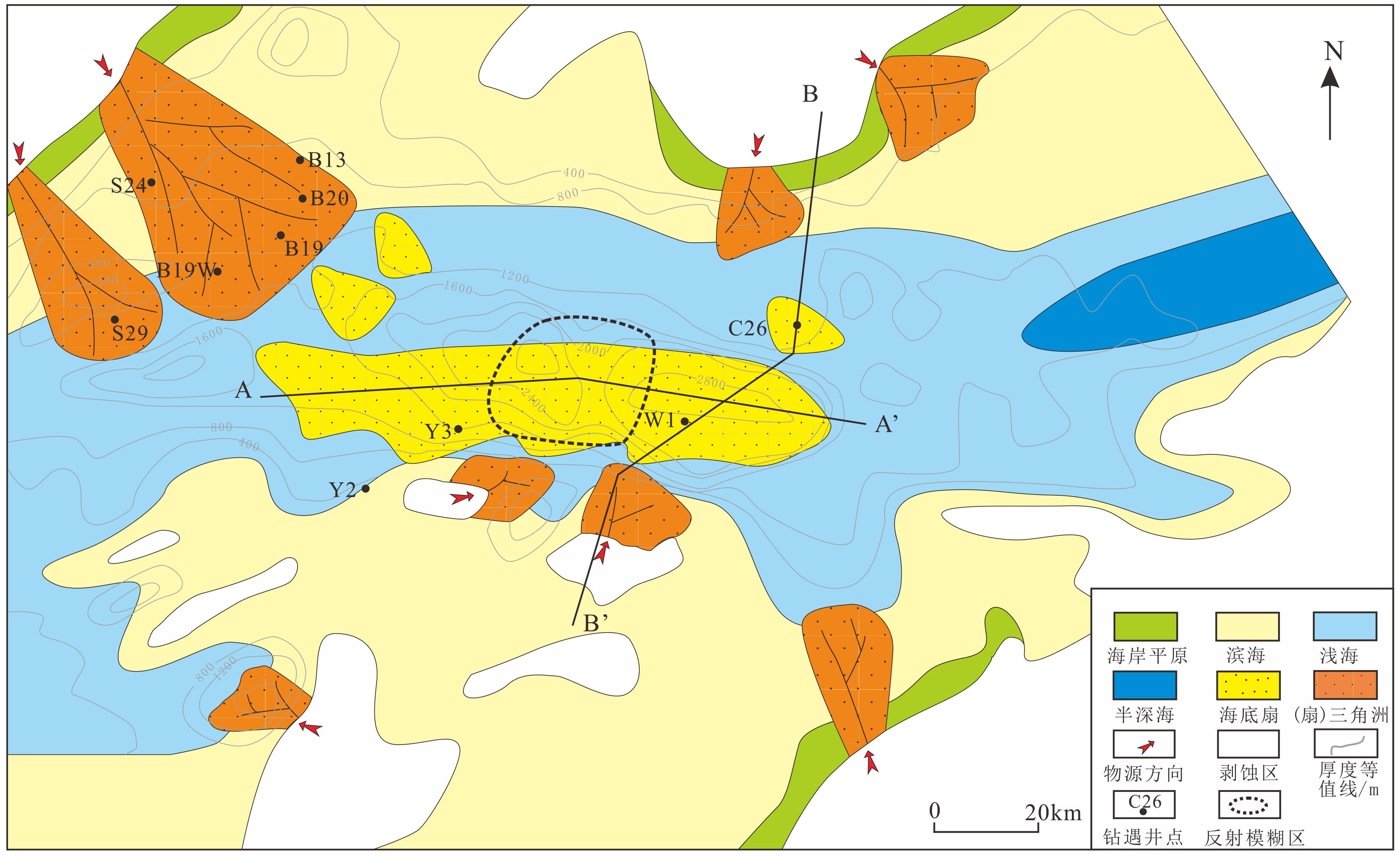Differential control of structures over reservoirs and its significance in Qiongdongnan Basin
-
摘要:
运用构造解析方法,通过精细地震资料解释和断层活动性分析,对琼东南盆地东西分块差异构造演化特征及其构造控藏差异进行了深入研究。根据区域构造差异,首次厘定了松南凹陷与宝岛凹陷边界,并分析认为该边界为琼东南盆地东西区分块差异构造演化边界。以此为界,盆地西区以北东构造走向为主,以发育大型简单铲式断层控制的大型地堑、半地堑凹陷为特征;盆地东区以近东西构造走向为主,以发育Y字型断层、铲状及板状阶梯断层控制的大型地堑、复式地堑为特征。综合分析认为,琼东南盆地东西分块差异构造演化的主控因素主要有三点:限制性边界条件、地壳结构与热流差异、差异构造地质因素。限制性边界条件差异与区域构造应力场转换是控制盆地东西分块断裂时空差异的主控因素,而地壳结构与热流差异和差异构造地质因素最终加剧了盆地东西区差异演化。在此基础上,开展了琼东南盆地深水区构造差异控藏综合研究,主要包括烃源岩、沉积体系及成藏区带差异研究,认为深水西区凹陷半地堑结构窄深,以发育海陆过渡相及陆源海相烃源岩类型为主,烃源岩埋深大,热演化程度高,生排烃时间晚,成藏层系以新近系重力流沉积为主,受半地堑凹陷结构控制主要发育3个成藏区带:陡坡带沟源断层垂向运移成藏区带、中央带高压底辟裂隙垂向运移成藏区带和缓坡带侧向运移成藏区带,以前两种成藏区带最优。深水东区(复式)地堑结构宽浅,以发育陆源海相烃源岩类型为主,烃源岩埋深浅,热演化程度中等,生排烃时间早,成藏层系以前古近系潜山及古近系三角洲海陆过渡相沉积为主,受地堑结构控制对称发育4个成藏区带:南北部凸起区断-砂-脊复合疏导格架侧向运移成藏区带和两侧近凹断阶带断层垂向运移成藏区带,这4四个区带成藏条件有利,均有油气发现,应为下步勘探重点领域。
Abstract:Using the method of structural analysis, the differential structural evolution characteristics and their control on difference in reservoirs between the east and west blocks in the deep-water areas of the Qiongdongnan Basin are studied in depth through fine interpretation of seismic data and analysis of fault activities. The boundary between Songnan sag and Baodao sag is delineated by detailed structural analysis, and the structural transitional zone is considered as the boundary of differential tectonic evolution between the east and west blocks of the Qiongdongnan Basin. Taking this as the boundary, the western basin is NE trended and characterized by the development of large grabens and half graben depressions controlled by large simple listric faults; the eastern basin, however, is EW in trend and characterized by the development of large grabens and composite grabens jointly controlled by Y-shaped faults, stepped spade and plate-shaped faults. Analysis shows that there are three controlling factors for the differential tectonic evolution of the east and west blocks of the Qiongdongnan Basin, i.e the restrictive boundary conditions, differences in crustal structure and heat flow, and differential structural geological influence factors. The differences in restrictive boundary conditions and the change in regional tectonic stress field are the main factors controlling the temporal and spatial differences of faults in the basin, while the last two factors eventually aggravate the differential evolution of the eastern and western regions of the basin. On this basis, a comprehensive study on the differences in petroleum systems in the deep-water area of the Qiongdongnan basin is carried out, which includes the differences in source rocks, sedimentary systems and petroleum accumulation systems. It is considered that the western deep-water area is dominated by the source rocks of transitional facies and terrigenous marine facies under large burial depth, high thermal evolution degree, and late hydrocarbon generation and expulsion time, controlled by the structure of half graben depression structure. Three accumulation systems are well developed: vertical migration-accumulation system through depression controlling fault in steep slope zone, vertical migration-accumulation system through high pressure diapirs-fractures in the central zone and lateral migration-accumulation system in the gentle slope zone. Borehole drillings have confirmed that the former two systems are the best. In contrast, the eastern deep-water area is dominated by marine source rocks under shallow burial depth, moderate thermal evolution, early generation and expulsion of hydrocarbon. Controlled by the graben structure, four zones of hydrocarbon accumulation systems are developed symmetrically: the lateral migration-accumulation systems through faults and sand ridge migrating framework in uplift zones and vertical migration-accumulation systems on both sides of the stepped faults in near depression zones. The accumulation conditions of the two areas are favorable for hydrocarbon accumulation and should be the next target for exploration.
-

-
[1] 施和生, 杨计海, 张迎朝, 等. 琼东南盆地地质认识创新与深水领域天然气勘探重大突破[J]. 中国石油勘探, 2019, 24(6):691-698 doi: 10.3969/j.issn.1672-7703.2019.06.001
SHI Hesheng, YANG Jihai, ZHANG Yingzhao, et al. Geological understanding innovation and major breakthrough to natural gas exploration in deep water in Qiongdongnan Basin [J]. China Petroleum Exploration, 2019, 24(6): 691-698. doi: 10.3969/j.issn.1672-7703.2019.06.001
[2] 胡杨, 张伟, 张景茹, 等. 南海北部大陆边缘琼东南盆地有利油气聚集带及勘探方向[J]. 海洋地质与第四纪地质, 2015, 35(4):73-86
HU Yang, ZHANG Wei, ZHANG Jingru, et al. The favorable petroleum accumulation belts and exploration targets in Qiongdongnan Basin on the margin of northern South China Sea [J]. Marine Geology and Quaternary Geology, 2015, 35(4): 73-86.
[3] 谢玉洪. 南海北部自营深水天然气勘探重大突破及其启示[J]. 天然气工业, 2014, 34(10):1-8
XIE Yuhong. A major breakthrough in deepwater natural gas exploration in a self-run oil/gas field in the northern South China Sea and its enlightenment [J]. Natural Gas Industry, 2014, 34(10): 1-8.
[4] 姚哲, 王振峰, 左倩媚, 等. 琼东南盆地中央峡谷深水大气田形成关键要素与勘探前景[J]. 石油学报, 2015, 36(11):1358-1366 doi: 10.7623/syxb201511005
YAO Zhe, WANG Zhenfeng, ZUO Qianmei, et al. Critical factors for the formation of large-scale deepwater gas field in Central Canyon System of Southeast Hainan Basin and its exploration potential [J]. Acta Petrolei Sinica, 2015, 36(11): 1358-1366. doi: 10.7623/syxb201511005
[5] 雷超. 琼东南盆地深水区盆地结构构造及其形成机制研究[D]. 中国地质大学硕士学位论文, 2009.
LEI Chao. Basin structure and its formation mechanism in deep water areas of Qiongdongnan Basin, South China Sea[D]. Master Dissertation of China University of Geosciences, 2009.
[6] 雷超, 任建业, 裴健翔, 等. 琼东南盆地深水区构造格局和幕式演化过程[J]. 地球科学-中国地质大学学报, 2011, 36(1):151-162
LEI Chao, REN Jianye, PEI Jianxiang, et al. Tectonic framework and multiple episode tectonic evolution in deepwater area of Qiongdongnan Basin, northern continental margin of South China Sea [J]. Earth Science-Journal of China University of Geosciences, 2011, 36(1): 151-162.
[7] 雷超, 任建业, 李绪深, 等. 琼东南盆地深水区结构构造特征与油气勘探潜力[J]. 石油勘探与开发, 2011, 38(5):560-569
LEI Chao, REN Jianye, LI Xushen, et al. Structural characteristics and petroleum exploration potential in the deep-water area of the Qiongdongnan Basin, South China Sea [J]. Petroleum Exploration and Development, 2011, 38(5): 560-569.
[8] 甘军, 张迎朝, 梁刚, 等. 琼东南盆地深水区烃源岩沉积模式及差异热演化[J]. 地球科学, 2019, 44(8):2627-2635
GAN Jun, ZHANG Yingzhao, LIANG Gang, et al. Deposition pattern and differential thermal evolution of source rocks, deep water area of Qiongdongnan Basin [J]. Earth Science, 2019, 44(8): 2627-2635.
[9] 韩光明, 李绪深, 王立锋, 等. 琼东南盆地宝岛凹陷北坡断裂体系新认识及与天然气成藏关系[J]. 天然气地球科学, 2013, 24(2):352-355
HAN Guangming, LI Xushen, WANG Lifeng, et al. New explanation of fault system in Baodao sag’s northern slope of Qiongdongnan Basin and its affect for natural gas accumulation [J]. Natural Gas Geoscience, 2013, 24(2): 352-355.
[10] 杨庚兄, 尹宏伟, 朱继田, 等. 三维扫描技术在构造物理模拟中的应用——以琼东南盆地为例[J]. 实验室研究与探索, 2020, 39(5):8-11, 45 doi: 10.3969/j.issn.1006-7167.2020.05.002
YANG Gengxiong, YIN Hongwei, ZHU Jitian, et al. Application of 3D scanning technology in physical modeling: taking Qiongdongnan Basin as an example [J]. Research and Exploration in Laboratory, 2020, 39(5): 8-11, 45. doi: 10.3969/j.issn.1006-7167.2020.05.002
[11] 张迎朝, 甘军, 杨希冰, 等. 琼东南盆地陵水凹陷构造演化及其对深水大气田形成的控制作用[J]. 海洋地质前沿, 2017, 33(10):22-31
ZHANG Yingzhao, GAN Jun, YANG Xibing, et al. Tectonic evolution and its constraints on the formation of deepwater giant gas field in Lingshui sag, Qiongdongnan Basin [J]. Marine Geology Frontiers, 2017, 33(10): 22-31.
[12] 李绪宣. 琼东南盆地构造动力学演化及油气成藏研究[D]. 中国科学院研究生院(广州地球化学研究所)博士学位论文, 2004.
LI Xuxuan. Tectonic dynamic evolution and hydrocarbon accumulation in Qiongdongnan Basin[D]. Doctor Dissertation of Graduate School of Chinese Academy of Sciences (Guangzhou Institute of Geochemistry), 2004.
[13] 唐晓音, 胡圣标, 张功成, 等. 南海北部大陆边缘盆地地热特征与油气富集[J]. 地球物理学报, 2014, 57(2):572-585 doi: 10.6038/cjg20140221
TANG Xiaoyin, HU Shengbiao, ZHANG Gongcheng, et al. Geothermal characteristics and hydrocarbon accumulation of the northern marginal basins, South China Sea [J]. Chinese Journal of Geophysics, 2014, 57(2): 572-585. doi: 10.6038/cjg20140221
[14] 丘学林, 施小斌, 阎贫, 等. 南海北部地壳结构的深地震探测和研究新进展[J]. 自然科学进展, 2003, 13(3):231-236 doi: 10.3321/j.issn:1002-008X.2003.03.002
QIU Xuelin, SHI Xiaobin, YAN Pin, et al. New progress in deep seismic exploration and study of crustal structure in the northern South China Sea [J]. Progress in Natural Science, 2003, 13(3): 231-236. doi: 10.3321/j.issn:1002-008X.2003.03.002
[15] 施小斌, 于传海, 陈梅, 等. 南海北部陆缘热流变化特征及其影响因素分析[J]. 地学前缘, 2017, 24(3):56-64
SHI Xiaobin, YU Chuanhai, CHEN Mei, et al. Analyses of variation features and influential factors of heat flow in the northern margin of the South China Sea [J]. Earth Science Frontiers, 2017, 24(3): 56-64.
[16] 施小斌, 王振峰, 蒋海燕, 等. 张裂型盆地地热参数的垂向变化与琼东南盆地热流分布特征[J]. 地球物理学报, 2015, 58(3):939-952 doi: 10.6038/cjg20150320
SHI Xiaobin, WANG Zhenfeng, JIANG Haiyan, et al. Vertical variations of geothermal parameters in rifted basins and heat flow distribution features of the Qiongdongnan Basin [J]. Chinese Journal of Geophysics, 2015, 58(3): 939-952. doi: 10.6038/cjg20150320
[17] 米立军, 袁玉松, 张功成, 等. 南海北部深水区地热特征及其成因[J]. 石油学报, 2009, 30(1):27-32 doi: 10.3321/j.issn:0253-2697.2009.01.005
MI Lijun, YUAN Yusong, ZHANG Gongcheng, et al. Characteristics and genesis of geothermal field in deep-water area of the northern South China Sea [J]. Acta Petrolei Sinica, 2009, 30(1): 27-32. doi: 10.3321/j.issn:0253-2697.2009.01.005
[18] 李三忠, 索艳慧, 刘鑫, 等. 南海的基本构造特征与成因模型: 问题与进展及论争[J]. 海洋地质与第四纪地质, 2012, 32(6):35-53
LI Sanzhong, SUO Yanhui, LIU Xin, et al. Basic structural pattern and tectonic models of the South China Sea: problems, advances and controversies [J]. Marine Geology and Quaternary Geology, 2012, 32(6): 35-53.
[19] 刘绍文, 施小斌, 王良书, 等. 南海成因机制及北部岩石圈热-流变结构研究进展[J]. 海洋地质与第四纪地质, 2006, 26(4):117-124
LIU Shaowen, SHI Xiaobin, WANG Liangshu, et al. Recent advances in studies on the formation mechanism of the South China Sea and thermo-rheological structure of lithosphere in its northern margin: an overview [J]. Marine Geology and Quaternary Geology, 2006, 26(4): 117-124.
[20] 张亮. 南海构造演化模式及其数值模拟[D]. 中国科学院研究生院(海洋研究所)博士学位论文, 2012.
ZHANG Liang. Tectonic evolution of the South China Sea and a numerical modeling[D]. Doctor Dissertation of Graduate School of Chinese Academy of Sciences (Institute of Oceanography), 2012.
[21] 万玲, 姚伯初, 吴能友. 红河断裂带入海后的延伸及其构造意义[J]. 南海地质研究, 2000(12):22-32
WAN Ling, YAO Bochu, WU Nengyou. The extending of Honghe faults in the South China Sea and its tectonic significance [J]. Gresearch of Eological South China Sea, 2000(12): 22-32.
[22] 徐子英, 孙珍. 琼东南盆地西南部反转构造发育机制物理模拟[J]. 海洋地质前沿, 2015, 31(8):47-52
XU Ziying, SUN Zhen. Analogue modeling of reversed structural deformation in the southwestern Qiongdongnan Basin [J]. Marine Geology Frontiers, 2015, 31(8): 47-52.
[23] 张迎朝, 甘军, 徐新德, 等. 琼东南盆地海相烃源岩的发现与勘探意义[J]. 煤炭技术, 2020, 39(2):43-45
ZHANG Yingzhao, GAN Jun, XU Xinde, et al. Marine source rock discovery and exploration significance in Qiongdongnan Basin [J]. Coal Technology, 2020, 39(2): 43-45.
[24] 孙瑞, 韩银学, 曾清波, 等. 琼东南盆地深水区东段崖城组沉积特征及对海相烃源岩的控制[J]. 石油学报, 2019, 40(S2):57-66
SUN Rui, HAN Yinxue, ZENG Qingbo, et al. Sedimentary characteristics of Yacheng formation in the eastern deepwater area in Qiongdongnan Basin and their control on marine source rocks [J]. Acta Petrolei Sinica, 2019, 40(S2): 57-66.
[25] 梁刚, 甘军, 李兴. 琼东南盆地陵水凹陷天然气成因类型及来源[J]. 中国海上油气, 2015, 27(4):47-53
LIANG Gang, GAN Jun, LI Xing. Genetic types and origin of natural gas in Lingshui sag, Qiongdongnan basin [J]. China Offshore Oil and Gas, 2015, 27(4): 47-53.
[26] 吴景富, 杨树春, 张功成, 等. 南海北部深水区盆地热历史及烃源岩热演化研究[J]. 地球物理学报, 2013, 56(1):170-180 doi: 10.6038/cjg20130117
WU Jingfu, YANG Shuchun, ZHANG Gongcheng, et al. Geothermal history and thermal evolution of the source rocks in the deep-water area of the northern South China Sea [J]. Chinese Journal of Geophysics, 2013, 56(1): 170-180. doi: 10.6038/cjg20130117
[27] 苏明, 解习农, 王振峰, 等. 南海北部琼东南盆地中央峡谷体系沉积演化[J]. 石油学报, 2013, 34(3):467-478 doi: 10.7623/syxb201303007
SU Ming, XIE Xinong, WANG Zhenfeng, et al. Sedimentary evolution of the central Canyon system in Qiongdongnan Basin, northern South China Sea [J]. Acta Petrolei Sinica, 2013, 34(3): 467-478. doi: 10.7623/syxb201303007
[28] 范彩伟, 李绪深, 刘昆, 等. 琼东南盆地乐东、陵水凹陷中新统岩性地层圈闭成藏条件[J]. 中国海上油气, 2016, 28(2):53-59
FAN Caiwei, LI Xushen, LIU Kun, et al. Hydrocarbon accumulation condition of Miocene litho-stratigraphic trap in Ledong & Lingshui sags, Qiongdongnan basin [J]. China Offshore Oil and Gas, 2016, 28(2): 53-59.
[29] 苏明, 张成, 解习农, 等. 深水峡谷体系控制因素分析——以南海北部琼东南盆地中央峡谷体系为例[J]. 中国科学: 地球科学, 2014, 57(10):2457-2468 doi: 10.1007/s11430-014-4878-4
SU Ming, ZHANG Cheng, XIE Xinong, et al. Controlling factors on the submarine canyon system: a case study of the Central Canyon System in the Qiongdongnan Basin, northern South China Sea [J]. Science China: Earth Sciences, 2014, 57(10): 2457-2468. doi: 10.1007/s11430-014-4878-4
[30] 谢玉洪, 李绪深, 范彩伟, 等. 琼东南盆地上中新统黄流组轴向水道源汇体系与天然气成藏特征[J]. 石油勘探与开发, 2016, 43(4):521-528
XIE Yuhong, LI Xushen, FAN Caiwei, et al. The axial channel provenance system and natural gas accumulation of the Upper Miocene Huangliu Formation in Qiongdongnan Basin, South China Sea [J]. Petroleum Exploration and Development, 2016, 43(4): 521-528.
[31] 钟佳, 杨希冰, 朱沛苑, 等. 琼东南盆地宝岛-长昌凹陷陵水组储层差异演化特征[J]. 地球科学, 2019, 44(8):2665-2676
ZHONG Jia, YANG Xibing, ZHU Peiyuan, et al. Porosity evolution differences of the Lingshui formation reservoir between Baodao and Changchang Sag, Qiongdongnan Basin [J]. Earth Science, 2019, 44(8): 2665-2676.
[32] 王振峰, 孙志鹏, 张迎朝, 等. 南海北部琼东南盆地深水中央峡谷大气田分布与成藏规律[J]. 中国石油勘探, 2016, 21(4):54-64 doi: 10.3969/j.issn.1672-7703.2016.04.006
WANG Zhenfeng, SUN Zhipeng, ZHANG Yingzhao, et al. Distribution and hydrocarbon accumulation mechanism of the giant deepwater Central Canyon gas field in Qiongdongnan Basin, northern South China Sea [J]. China Petroleum Exploration, 2016, 21(4): 54-64. doi: 10.3969/j.issn.1672-7703.2016.04.006
[33] 张迎朝, 徐新德, 甘军, 等. 琼东南盆地深水大气田地质特征、成藏模式及勘探方向研究[J]. 地质学报, 2017, 91(7):1620-1633 doi: 10.3969/j.issn.0001-5717.2017.07.013
ZHANG Yingzhao, XU Xinde, GAN Jun, et al. Study on the geological characteristics, accumulation model and exploration direction of the giant deepwater gas field in the Qiongdongnan Basin [J]. Acta Geologica Sinica, 2017, 91(7): 1620-1633. doi: 10.3969/j.issn.0001-5717.2017.07.013
[34] 沈怀磊, 张功成, 孙志鹏, 等. 琼东南盆地深水区富气凹陷形成控制因素与勘探实践——以陵水凹陷为例[J]. 石油学报, 2013, 34(S2):83-90 doi: 10.7623/syxb2013S2010
SHEN Huailei, ZHANG Gongcheng, SUN Zhipeng, et al. Formation control factor analysis and exploration practice in gas-rich sag in deep-water areas of Qiongdongnan Basin: a case study of Lingshui sag [J]. Acta Petrolei Sinica, 2013, 34(S2): 83-90. doi: 10.7623/syxb2013S2010
-




 下载:
下载:










